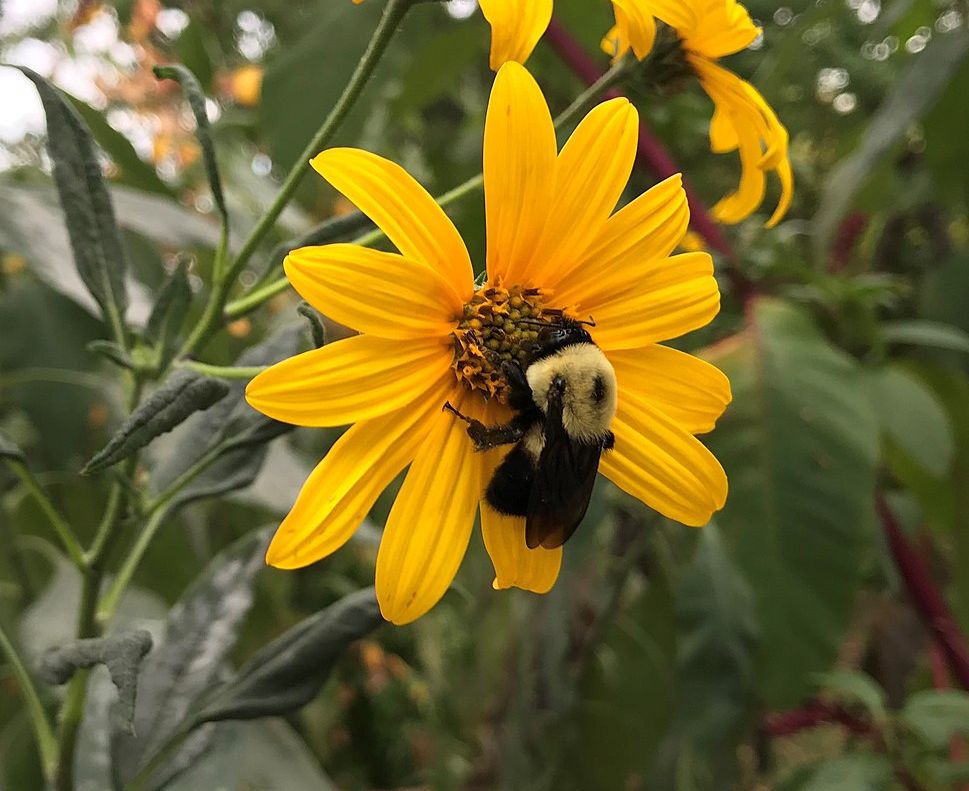
7 August 2023
If you’re not on X formerly-known-as-Twitter, you missed this very informative thread about the reason why native bumblebees sleep on flowers in July (and August).
The thread was posted on 22 July by The Bee Guy @the_beeguy, Paul Handrick, in which he described the behavior of wild bees in late summer. It catapulted him to fame and prompted an article in The Irish Times about The Bee Sanctuary of Ireland, founded by Handrick and his wife Claire-Louise Donelan. It’s the only wild bee sanctuary on the planet.
Handrick’s information is very timely and, because I have yet to find it anywhere else, I have embedded @the_beeguy’s thread below. The social media platform X, formerly known as Twitter, is in flux so I don’t know how long his thread will be available. (I have noticed that it can take a while for the tweets to come in.) Read it while you can! It’s worth it.
And have a look at The Irish Times: The Wicklow couple with the world’s only wild bee sanctuary: ‘They are in trouble’.
Spoiler alert:
— The Bee Guy (@the_beeguy) July 22, 2023
To sleep on a flower may appear romantic and magical but the reality can seem more tragic than magic for the bumblebees involved.
Flower sleeping #bumblebees are primarily males.
They don’t have a dad.
Once mature, males leave the nest and never return.
2/16 pic.twitter.com/7LJQkX7sSs
…foraging in inclement weather or too late & losing light, low energy & natural end of life. But at this time of year – mid to late summer – you may notice a big increase in ‘flower sleepers’ and most of these will likely be males. So let’s take a look at male #bumblebees..
— The Bee Guy (@the_beeguy) July 22, 2023
4/16 pic.twitter.com/5NOVi1UTUV
…mother the queen. When developing as larvae they require more food and for a longer time period than female worker larvae. Ironically later in their short lives males will never forage for pollen and nectar to contribute to the nest but concentrate on foraging for nectar…
— The Bee Guy (@the_beeguy) July 22, 2023
6/16 pic.twitter.com/ShCRQ7Cz1P
…to avoid inbreeding (take note some humans ?).
— The Bee Guy (@the_beeguy) July 22, 2023
This is where the ‘flower sleeping’ starts. Having no homes these males will now spend their days actively seeking a new queen to mate with and food to sustain themselves. They will travel up to 17 kilometres in a single day…8/16 pic.twitter.com/2nVEkU2cNI
…specific height preferences at which they patrol spreading their queen attracting scent. Some work their magic in the tree tops while others are more down to earth! Despite mating being their raison d’être the sad fact is that very few males (estimates put it at less…
— The Bee Guy (@the_beeguy) July 22, 2023
10/16 pic.twitter.com/YV4wwZmR2M
…of the tibia that is. (Stop it!). Males with longer fore and hind legs are more successful at mating.
— The Bee Guy (@the_beeguy) July 22, 2023
So those lethargic #bumblebees that you find early morning on flowers at this time of year – especially #thistles as males have a sweet tooth and thistle nectar is…
12/16 pic.twitter.com/PQIH9rN7l1
All females develop a stinger but the equivalent part of the body in males develops into the genital capsule.
— The Bee Guy (@the_beeguy) July 22, 2023
When males raise that middle leg to warn you to back off it’s just a bluff with no sting to back it up.
So when it comes to #bumblebees the males…
14/16 pic.twitter.com/ExR587BW2X
Hope this provides a little bit of insight and creates a little more #empathy towards these wonderful creatures.
— The Bee Guy (@the_beeguy) July 22, 2023
Thanks for reading.
Please share to spread further the knowledge. #retweet
And please do still dream of sleeping in #flowers.
Have a great one!#bees
16/16 pic.twitter.com/ikggmMZ0QQ
(photo from Wikimedia Commons, tweets embedded from @the_beeguy)